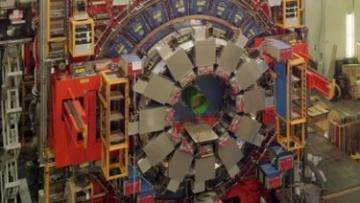November 4, 2008 weblog
Fermilab's CDF Result Sparks Rumors of New Physics

(PhysOrg.com) -- Where are the muon-muon pairs coming from?
That's the question that has been consuming the blogs of physicists and others since late last week. Intrigued by a new study published by Fermilab´s CDF collaboration at arxiv.org, scientists are speculating - with great caution - that unusual muon-muon observations could point to physics beyond the Standard Model.
Although more information will surely follow in the coming weeks, the gist of the excitement is this: When observing decay events that produce a b meson and anti-meson (b-bbar) pair, which has a lifetime of about a picosecond, physicists found something unexpected in the background. When further investigating the background, the physicists discovered several surprises.
Among the unusual properties of the events is the production of an anomalously high number of muon pairs. In 300,000 events, about 70,000 contained more muons than expected, which cannot be attributed to statistical fluctuation. According to Peter Woit, a mathematician at Columbia University, on his blog "Not Even Wrong,", "One gets what one would expect to see from the decay of a new, unknown particle with a lifetime of about 20 picoseconds." However, the paper doesn´t propose a new particle, and it´s still too early to do more than speculate on the cause.
"The exciting possibility here is that a new, relatively long-lived particle has been observed, one that decays in some way that leads to a lot more muons than one gets from Standard Model states," Woit wrote. "It should be remembered though that this is an extraordinary claim requiring extraordinary evidence, and the possibility remains that this is some sort of background or detector effect that the CDF physicists have missed. It should also be made clear that this paper is not a claim by CDF to have discovered a new particle, rather it is written up as a description of the anomalies they have found, leaving open the possibility that these come from some standard model processes or detector characteristics that they do not yet understand."
The observation and its implications are so puzzling that only about two-thirds of the 600 CDF physicists chose to attach their names to the publication, called "Study of multi-muon events produced in p-pbar collisions at sqrt(s)=1.96 TeV," which is submitted to Physical Review D. According to the blog of Tommaso Dorigo, CDF physicist, the authors wanted to publish it soon because of a legitimate concern that the news had started to leak out. Yet some CDF scientists wanted more analysis before publishing, so they left their names off the paper.
While the original paper didn´t offer an explanation for the signal, a second publication that appeared on arxiv a few days later, authored by seven CDF physicists, offers a possible explanation. As Woit noted, the multi-muon anomaly has already generated three conjectural explanations of the physics behind the signal, and "undoubtedly many, many more are on the way."
Dorigo said that one thing that makes this observation so unusual is that not even alternative theories of new physics have predicted such a signal. "As far as I understand, no existing model of new physics predicted such a signature in advance, although one must acknowledge that a few ideas exist in the literature which might have a connection with the effect, if proven real."
Fermilab´s other detector, D0, will likely perform similar searches for the unusual muon-muon signal. Even though D0 has a very good muon system, analyzing the data could still take a while.
Whether or not this particular result proves to lead toward something new, it offers some unexpected excitement while the new LHC undergoes repair until next spring. It´s one of the most exciting results to emerge from particle physics in a while, and suggests that the LHC, when it does start collecting data, could find some very interesting things.
More information:
Original paper: Study of multi-muon events produced in p-pbar collisions at sqrt(s)=1.96 TeV
Second paper: Phenomenological interpretation of the multi-muon events reported by the CDF collaboration
Peter Woit´s blog "Not Even Wrong"
Tommaso Dorigo´s blog "A Quantum Diaries Survivor"




















